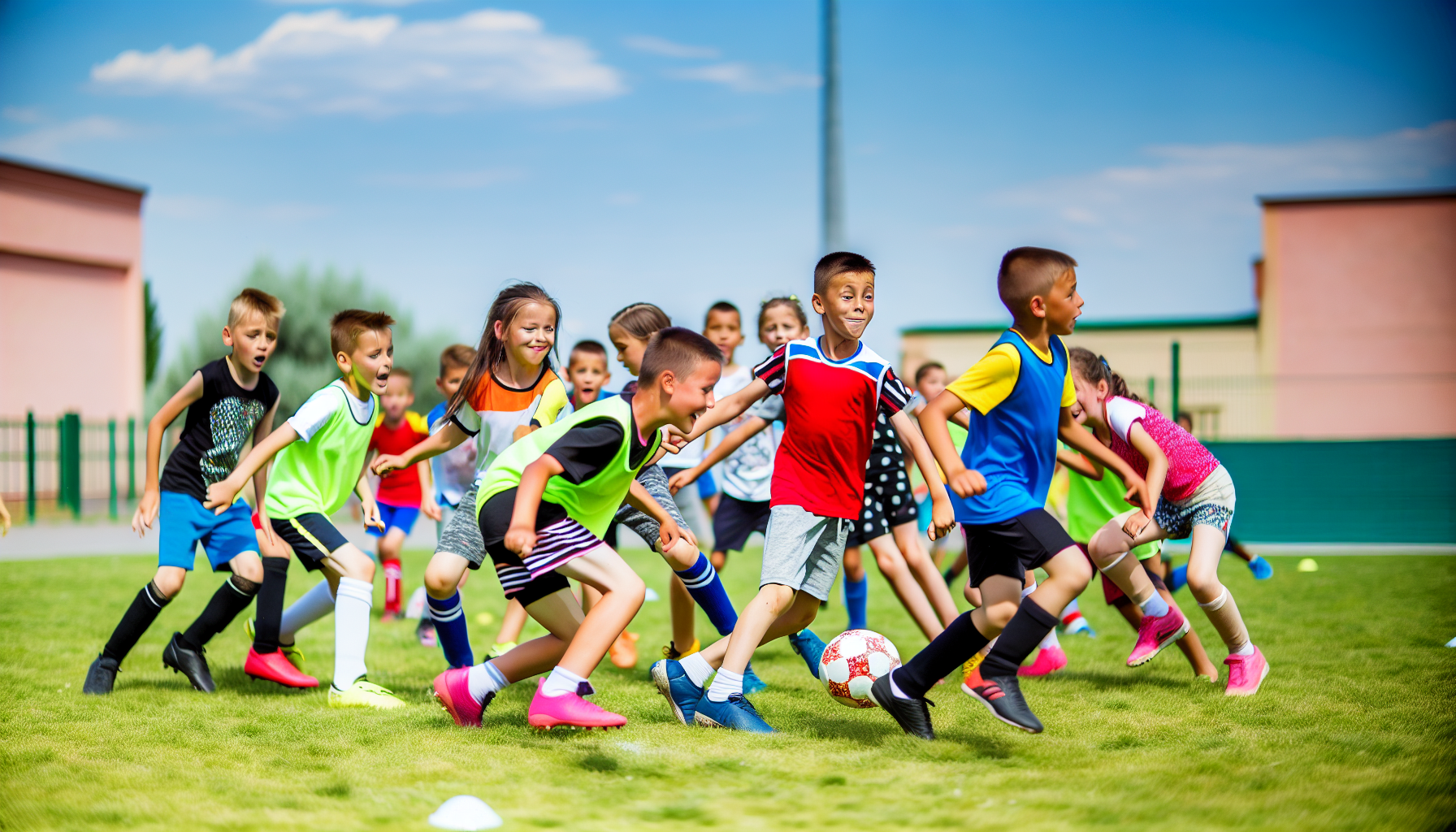As a parent, do you wonder which sport will help your elementary school kid thrive both on and off the field? This parent’s guide, “Choosing the Right Sport for Your Elementary School Kid: A Parent’s Guide,” is your ally in focusing on your child’s interests, developmental stage, and personal growth. Navigate through youth athletics with confidence as we provide insights into sports that will foster their physical activity, social skills, and pure enjoyment. Embark on a clear path to a sound decision for your young athlete’s happy, healthy sporting experience.
Table of Contents
ToggleKey Takeaways
- Choose sports that match your child’s interests and developmental stage, with an emphasis on enjoyment and skill development over winning.
- Balance the child’s sports activities with family time and other interests, while managing the financial and time commitments involved in sports participation.
- Encourage healthy competition, good sportsmanship, and the value of teamwork, while ensuring the safety and fun aspect of sports to promote a lifelong commitment to physical activity.
Assessing Your Child’s Interests

Assessing a child’s interest in sports is more than just a way to keep them active. It’s an opportunity to impart family values and personal development goals, encouraging them to express their individuality.
A lasting commitment to physical activity can be fostered by offering children a variety of sports to choose from, which can also introduce healthy practices.
Conversation Starters
Engaging conversations about sports can empower children to share their preferences, making them feel a sense of ownership over their sports decisions. Ask them what they seek in a sports experience, such as:
- action
- freedom
- competition
- inclusion
- connection
The focus should be on enjoyment and development of skills.
Observational Tips
Observing your child’s play habits can provide valuable insights into their potential sports interests. Pay attention to:
- The activities they choose during unstructured playtime
- Their responses to informal physical activities
- Their enthusiasm when they successfully complete a physical task or game.
These observations can suggest which popular sports might be most rewarding and engaging for them.
Physical & Social Development Considerations

Choosing age-appropriate sports that align with your child’s physical and social development can ensure a positive and engaging experience. Physical activity is essential for a child’s growth and development, and team sports can teach them invaluable social skills.
Age-Appropriate Sports
Selecting sports that are appropriate for your child’s young age is key to promoting their physical development and enjoyment. For instance, children aged 2 to 5 should engage in unstructured sports that develop basic motor skills like running, swimming, and catching. Youth sports programs like YMCA Rookie Sports, which show-and-tell format of instruction, are ideal for this age group.
As your child grows, their sports should evolve too. For kids ages 6 to 9, they are generally ready for simple organized sports, with flexible rules to facilitate participation and learning. By the ages of 10 to 12, they can engage in more complex sports that require teamwork and strategy. However, the emphasis for this age should still remain on having fun and developing skills over winning.
Social Dynamics in Team Sports
Team sports play a significant role in teaching children to cooperate, be less selfish, and listen to others. A sense of belonging and making new friends through team sports helps to expand a child’s social circle beyond the school environment.
Observing your child’s interaction with others in group games versus solitary play can provide insights into their inclination towards team sports or individual activities.
Introducing Healthy Competition

Healthy competition is a vital aspect of youth sports. Teaching healthy competition to children should center on the enjoyment of the event, their effort, and teamwork, not just on the outcomes of winning or losing. This approach can help cultivate a lifelong appreciation for staying active and teach friendly competition.
The Role of Winning and Losing
In sports, children learn to manage disappointment and foster resilience, preparing them for life’s highs and lows. Experiences of winning and losing can shape a child’s self-esteem; winning can uplift, while losing can be instructive by showing there’s room for improvement and persistence.
Good sportsmanship involves winning with humility, losing with grace, and respecting all participants.
Encouraging Sportsmanship
It is vital to instill sportsmanship in youth sports. Inclusivity in youth sports underscores the value of giving everyone a chance to play, teaching children the importance of respect and camaraderie with teammates and opponents. Respecting the decisions of referees and officials, and ending games with a handshake, instills in children respect for authority and the ability to conclude on a positive note.
Moreover, teaching children the following skills can help them handle outcomes constructively and with dignity during sports activities:
- Avoid blaming others for losses and accept responsibility
- Maintain concentration on the game and avoid arguments
- Quickly let go of mistakes and listen to constructive feedback
Guiding young athletes in developing leadership skills and life skills can contribute to their emotional maturity and resilience.
Exploring a Variety of Sports Programs

Children can develop well-rounded athleticism, interpersonal skills, and a lifelong love for staying active when they are exposed to various sports. Specialization in a single sport at an early age can increase the likelihood of overuse injuries and burnout, but exposure to a multitude of sports can mitigate this problem.
Multi-Sport Sampling
Encouraging children to participate in a variety of sports can foster a broad range of skills and prevent burnout. It can also offer long-term benefits as college coaches often look for athletes with a broad athletic skill set, suggesting a positive view on multi-sport experience.
Finding Local Youth Sports Leagues
Choosing a youth sports league, such as youth baseball, that aligns with your family’s values, schedule, and budget can ensure a supportive environment for your child’s athletic development. Investigate the disciplinary and motivational approaches of potential leagues to ensure they are compatible with your child’s requirements and the values of your family.
Practical Considerations for Parents

Parents should consider the impact of sports schedules on regular family activities and ensure that sports participation does not consume family time excessively. To avoid financial stress, parents should determine whether a sport’s fees are required up-front or can be spread out in monthly payments and choose accordingly based on their budget flexibility.
Balancing Time and Commitment
Maintaining a balanced lifestyle for your child is of utmost importance. Limiting them to one sport per season can help prevent over-scheduling and maintain a balance between sporting activities, other interests, and family time.
Allocating time for structured family activities such as weekly family dinners ensures that family connections remain strong even when sports schedules are hectic.
Budgeting for Sports Participation
For financial stability, it is imperative to manage sports-related expenses. Expenses fluctuate significantly by sport. Families can manage these expenses through various methods such as:
- Buying and selling used equipment
- Seeking discounts
- Limiting the number of sports played
- Coordinating carpools
- Opting for recreational leagues instead of more expensive travel teams.
The Importance of Positive Role Models
Instilling values and guiding young athletes is a critical role played by volunteer coaches, including the head coach. They are admired role models, guiding players to emulate behaviors that transcend the sport, emphasizing leadership and the importance of positive influences.
Safety and Injury Prevention
Ensuring your child’s safety in sports is paramount. This involves providing proper protective gear, training, and education on injury recognition and response.
Protective Gear and Training
To prevent injuries, it is vital to provide your child with sport-specific protective gear and teach them its correct usage. Some examples of gear that can protect young athletes from injuries in various sports are:
- Helmets
- Shin guards
- Mouth guards
- Ankle braces
- Shoes with rubber cleats
The effectiveness of protective gear in preventing sports-related injuries heavily relies on correct fitting and usage.
Recognizing and Responding to Injuries
It is essential to create a safety culture where children can comfortably report injuries. Coaches should be certified in first aid and CPR, ensuring a stocked first aid kit is available at every practice and game for immediate response to injuries.
Parents must be knowledgeable about concussion signs and symptoms, aiding in the quick identification of these injuries.
Nurturing Athletic Passion and Longevity
Sports can be a wonderful platform for personal growth, and playing sports teaches children the value of patience, persistence, and the joy of improvement. The key is to keep sports enjoyable and balanced with other aspects of life, encouraging a lifelong commitment to physical activity and personal growth.
Keeping Sports Fun
Keeping sports fun can maintain a child’s interest and prevent burnout. Emphasizing fun and prioritizing positive experiences helps create an environment where kids enjoy competition healthily and stay kids active.
Allowing children decision-making power about their sports involvement fosters enjoyment and a sense of ownership in the activity.
Encouraging Lifelong Physical Activity
Participation in youth sports, a form of organized sport, can establish long-term exercise habits that persist through adulthood, promoting healthy practices. The emphasis on exercise and teamwork experienced through youth sport can foster a lifelong commitment to maintaining an active lifestyle.
Summary
In conclusion, choosing the right sport for your child requires thorough understanding of their interests, physical and social development considerations, and the introduction of healthy competition. It’s about balancing time and commitment, budgeting for sports participation, and nurturing athletic passion for longevity. Above all, it’s about making sports a fun, enjoyable, and enriching part of your child’s life.
Frequently Asked Questions
How do I know what sport is right for my child?
To choose the right sport for your child, consider their activity level, physical traits, and what sports they enjoy. It’s also important to meet the coaches and to practice with them to see if it’s a good fit.
What are some guidelines for choosing sports?
When choosing a sport for yourself or your child, consider factors such as personal interests, physical abilities, and time commitment to find the right fit.
What is the best age to put your child in sports?
The best age to put your child in sports is around 6 years old, as most children develop the necessary physical skills and attention span at this age, while also being ready to understand the rules of the game. Each child is different, so readiness may vary.
What sport is most played by youth?
According to research by The Aspen Institute, the most popular sports played by youth are basketball, soccer, and baseball. Basketball leads with 36.8%, followed by soccer with 26.5%, and baseball with 24.1%.
What are some age-appropriate sports for my child?
For children aged 2 to 5, unstructured sports like soccer, basketball, and tee-ball are suitable, while children aged 6 to 9 can engage in soccer, baseball, tennis, gymnastics, and martial arts. By the ages of 10 to 12, they can participate in more complex sports that require teamwork and strategy.
Share this post: on Twitter on Facebook on Google+







